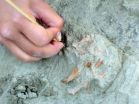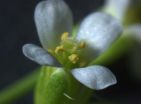(Press-News.org) Humans that populated the banks of the river Manzanares (Madrid, Spain) during the Middle Palaeolithic (between 127,000 and 40,000 years ago) fed themselves on pachyderm meat and bone marrow. This is what a Spanish study shows and has found percussion and cut marks on elephant remains in the site of Preresa (Madrid).
In prehistoric times, hunting animals implied a risk and required a considerable amount of energy. Therefore, when the people of the Middle Palaeolithic (between 127,000 and 40,000 years ago) had an elephant in the larder, they did not leave a scrap.
Humans that populated the Madrid region 84,000 years ago fed themselves on these prosbocideans' meat and they consumed their bone marrow, according to this new study. Until now, the scientific community doubted that consuming elephant meat was a common practice in that era due to the lack of direct evidence on the bones. It is still to be determined whether they are from the Mammuthus species of the Palaleoloxodon subspecies.
The researchers found bones with cut marks, made for consuming the meat, and percussion for obtaining the bone marrow. "There are many sites, but few with fossil remains with marks that demonstrate humans' purpose" Jose Yravedra, researcher at the Complutense University of Madrid (UCM) and lead author of the study published in the Journal of Archaeological Science points out to SINC.
This is the first time that percussion marks that showed an intentional bone fracture to get to the edible part inside have been documented. These had always been associated with tool manufacturing but in the remains found, this hypothesis was discarded. The tools found in the same area were made of flint and quartzite.
The team, made up of archaeologists, zooarchaeologists and geologists from UCM, the Institute of Human Evolution in Africa (IDEA) in Madrid and the Spanish National Research Centre for Human Evolution (CENIEH) in Burgos, collected 82 bones from one elephant, linked to 754 stone tools, in an area of 255 metres squared, in the site of Preresa, on the banks of the river Manzanares.
In the case of the cut marks on the fossil remains, these add to the "oldest evidence of exploiting elephants" in the site of Áridos, close to the river Jarama, according to another study published by Yravedra in the same journal. "There are few records about the exploitation of elephants in Siberia, North America and central Europe", the zooarchaeologist explains.
The risk of hunting an elephant
The internal organs were what the predator ate first, be they human or any kind of carnivore. The prehistoric signs of the banquet help researchers to find out who was the first to sit down at the table, as the risk of hunting an elephant posed the question as to whether humans hunted it or were scavengers.
"This is the next mystery to be solved" Yravedra replies, who reminds us that there is evidence of hunting in other smaller animals in the same site. However, due to the thickness of fibrous membranes and other elephant meat tissues, humans did not always leave marks on the bones. "And for this reason, sometimes it is difficult to determine if humans used their meat".
The 'Holy Grail' of Palaeolithic diet
Animal fat was highly valued by hunters and gatherers that had a diet rich in meat and low in carbohydrates. When there was little meat, other resources such as bone marrow became a source of lipids.
According to the study, this practice was not very common due to the difficulty of extracting the marrow from the bones. Furthermore "exploiting the fat is something that has not been reported until now" the researcher says. Other food sources, such as brains, had the same nutritional benefits.
INFORMATION:
References:
Yravedra, J.; Rubio-Jara, S.; Panera, J.; Uribelarrea, D.; Pérez-González, A. "Elephants and subsistence. Evidence of the human exploitation of extremely large mammal bones from the Middle Palaeolithic site of PRERESA (Madrid, Spain)". Journal of Archaeological Science 39 (4): 1063-1071, april 2012. DOI: 10.1016/j.jas.2011.12.004
'Inhabitants of Madrid' ate elephants’ meat and bone marrow 80,000 years ago
2012-04-25
ELSE PRESS RELEASES FROM THIS DATE:
ORNL, Yale take steps toward fast, low-cost DNA sequencing device
2012-04-25
Researchers at Oak Ridge National Laboratory and Yale University have developed a new concept for use in a high-speed genomic sequencing device that may have the potential to substantially drive down costs.
"The low cost--if it can be achieved--would enable genomic sequencing to be used in everyday clinical practice for medical treatments and preventions," said Predrag Krstic, project director and former ORNL physicist now at the University of Tennessee-ORNL Joint Institute for Computational Sciences.
The research is part of a nearly decade-long drive by the National ...
Soy-based S-equol supplement reduces hot flash frequency, muscle & joint pain in US women
2012-04-25
Northridge, Calif. (April 24, 2012) – A dose of 10 milligrams (mg) daily of S-equol delivered via a newly developed fermented soy germ-based nutritional supplement is as effective as a standard dose of soy isoflavones at reducing hot flash frequency significantly and is even more effective for relieving muscle and joint pain, according to a peer-reviewed study in US postmenopausal women published in the June Journal of Women's Health, available now as a Fast Track article online ahead of print.
"This study provides evidence that daily doses of the supplement S-equol, ...
Molecule movements that make us think
2012-04-25
VIDEO:
A research group at Linköping University has built five different molecular models of the voltage sensor in an ion channel, which together can explain all the experimental data. The five...
Click here for more information.
Every thought, every movement, every heartbeat is controlled by lightning-quick electrical impulses in the brain, the muscles, and the heart. But too much electrical excitability in the membranes of the cells can cause things like epilepsy and cardiac ...
PNAS: Precise molecular surgery in the plant genome
2012-04-25
This press release is available in German.
The new method is based on the natural repair mechanism of plants. So-called homologous recombination repairs the genome when the genome strands in the cell break. "Using an appropriate enzyme, i.e. molecular scissors, we first make a cut at the right point in the genome and then supply the necessary patch to repair this cut," says Friedrich Fauser from Karlsruhe Institute of Technology, who is the first author of the PNAS publication. "A part of this patch is the new gene piece we want to install. The rest is done by the ...
The search for a job begins and ends with you
2012-04-25
Staying motivated is always tough, but it certainly gets easier when you start seeing results. That's why keeping your spirits up during a job search can be extremely difficult. Candidates often face repeated rejection and rarely receive any feedback. A new study that focuses on finding work following a job layoff reveals just how important managing negative thoughts and effort over time are while looking for employment.
The research shows that having a more positive, motivational outlook had a beneficial effect on job pursuit, especially at the outset of the search. ...
Family history of liver cancer increases risk of developing the disease
2012-04-25
A family history of liver cancer is reported to increase risk of developing hepatocellular carcinomas (HCC), independent of hepatitis according to findings published in the May issue of Hepatology, a journal of the American Association for the Study of Liver Diseases. The study also shows 70-fold elevated risk of HCC in those with liver cancer in the family and markers for hepatitis B (HBV) or hepatitis C (HCV).
Liver cancer ranks sixth in incidence and the third cause of mortality worldwide. According to the World Health Organization (WHO) liver cancer was responsible ...
Fibrosis and fatty liver disease increase risk of early atherosclerosis
2012-04-25
Italian researchers report that severe fibrosis increases the early atherosclerosis risk in patients with genotype 1 chronic hepatitis C virus (HCV) infection. A second study found that fatty liver disease also increases risk of developing atherosclerosis at an earlier period. Both studies appear in the May issue of Hepatology, a journal published by Wiley-Blackwell on behalf of the American Association for the Study of Liver Diseases.
In the first study, researchers led by Dr. Salvatore Petta from the Di.Bi.M.I.S. University of Palermo in Italy evaluated 174 patients ...
Bile – not acid – is bad guy in triggering precancerous condition associated with reflux disease
2012-04-25
For many people with gastroesophageal reflux disease or GERD, acid reflux drugs are the answer to their woes, curbing the chronic heartburn and regurgitation of food or sour liquid characteristic of the disorder. But when it comes to Barrett's esophagus, a condition commonly found in people with GERD, acid control may be less important than beating back another bodily fluid – bile.
A new study published in the Annals of Surgery shows that bile – a digestive fluid that leaks backwards from the stomach into the esophagus along with acid in patients with GERD – plays a ...
Improving on the amazing: Ames Laboratory scientists seek new conductors for metamaterials
2012-04-25
AMES, Iowa -- Scientists at the U.S. Department of Energy's Ames Laboratory have designed a method to evaluate different conductors for use in metamaterial structures, which are engineered to exhibit properties not possible in natural materials. The work was reported this month in Nature Photonics.
Cloaking devices that hide planes from RADAR, microscopes that can see inside a single cell, and miniature antennae that measure only a few millimeters all sound like parts of a science fiction movie. But, within the span of the decade since they began their work, Ames Laboratory ...
Binge eating may lead to addiction-like behaviors
2012-04-25
HERSHEY, Pa. -- A history of binge eating -- consuming large amounts of food in a short period of time -- may make an individual more likely to show other addiction-like behaviors, including substance abuse, according to Penn State College of Medicine researchers. In the short term, this finding may shed light on the factors that promote substance abuse, addiction, and relapse. In the long term, may help clinicians treat individuals suffering from this devastating disease.
"Drug addiction persists as a major problem in the United States," said Patricia Sue Grigson, Ph.D., ...


